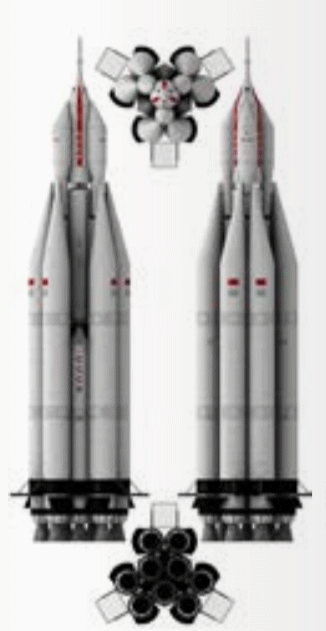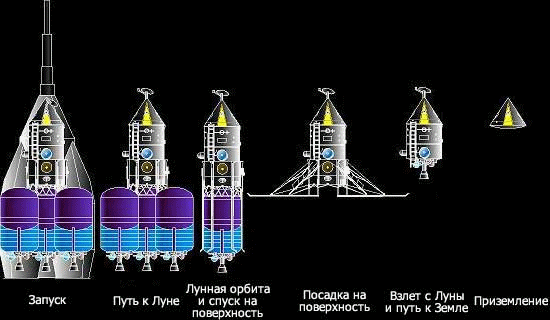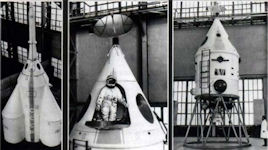UR-700
 The UR-700 is one of the more curious rockets in history. It was designed by the design office OKB-52 of Vladímir Cheloméi in 1962 with the aim of putting a man on the Moon using the method of direct ascent. With a capacity of 150 tons in low orbit (LEO), it would have been the most powerful rocket ever built. Rocket UR-700K superheavy carrier was based on the elements of the UR-500K rocket, later known as the "Proton". In the field of power plants Chelomey worked with KB Glushko, who developed powerful engines on highly toxic fuels: amyl (tetraoxide diazot) and heptyl (asymmetric dimethylhydrazine). The use of poisonous fuel is one of the reasons why the Proton did not take out ships with crew on board. All ready-made units, from which the UR-700 rocket could be assembled at the cosmodrome, fit into the 4100 mm dimensions, which allowed them to be transported on railway platforms. So it was possible to avoid the completion of the rocket at the launch site.
The UR-700 is one of the more curious rockets in history. It was designed by the design office OKB-52 of Vladímir Cheloméi in 1962 with the aim of putting a man on the Moon using the method of direct ascent. With a capacity of 150 tons in low orbit (LEO), it would have been the most powerful rocket ever built. Rocket UR-700K superheavy carrier was based on the elements of the UR-500K rocket, later known as the "Proton". In the field of power plants Chelomey worked with KB Glushko, who developed powerful engines on highly toxic fuels: amyl (tetraoxide diazot) and heptyl (asymmetric dimethylhydrazine). The use of poisonous fuel is one of the reasons why the Proton did not take out ships with crew on board. All ready-made units, from which the UR-700 rocket could be assembled at the cosmodrome, fit into the 4100 mm dimensions, which allowed them to be transported on railway platforms. So it was possible to avoid the completion of the rocket at the launch site.
The center OKB-52 of Chelomei by 1962 had in mind a successor for his UR-500K, the UR-700, a clear competitor of the N1 and the American Saturn-V. This vehicle could drive about 50 tons on the escape route or place 150 tons in low Earth orbit. The beast would have weighed more than 4,800 tons at launch, developing some 5,900 tons of thrust. Both the first and second stages would be formed by identical modules of propulsion modules (4.1 meters in diameter, a size suitable for transport by rail), each equipped with an engine RD-270, the new creation of Glushko. The RD-270, which would consume storable propellants, would have a thrust of 600 tons (it was the equivalent of the US F-1).
Thus, the first stage would be formed by three clusters of two propulsion modules each, in turn surrounding another three modules in a single central cluster that would act as a second stage. Both would burn at a time from the moment of the takeoff, although the second one would do it more time (at first it would be fed by the tanks of the first one). That supposed nine engines running at once, compared to five of the Saturn-V of NASA, which gives an idea of its power. On the second stage rested the third step, consisting of three engines RD-254 (height version of those already used in the first phase of the UR-500K), with tanks for propellants located externally and that could be expelled during the ascent. With the LK-700 ship at the top of the rocket, the whole would reach 76 meters in height.
Chelomei felt the main danger of the project H1-L3, which was developed by Korolev, was that the whole expedition consisted of several stages: the spacecraft was launched into an intermediate near-earth orbit, from which it was sent to the side of the moon, where it was decelerated and entered the orbit of its artificial satellite. After that, the landing module undocked from the orbital compartment, which landed on the Moon, after some stay on its surface it started, docked with the orbital compartment, where the crew went, after which the lunar module was disconnected, and the astronauts returned to the orbiter, from which Earth separated the descent vehicle with people home.
This scheme was implemented by the Americans during the implementation of the Apollo program. But such a scheme for that time was quite complicated. The spacecraft could not reach the circumlunar orbit, and the landing module could not dock with the orbital compartment. Now docking in space seems to be something trivial, but in the 1960s, methods of bringing together spacecraft were just being worked out. And the Soviet space program was several years behind.
For these reasons, direct landing on the moon at that time was very logical. The spacecraft was put on the trajectory of a direct hit at the desired point of our satellite, and landed without any complicated operations. This scheme is less effective, but it was more simple, and therefore reliable. There were other pluses. Now it was possible to sit down almost anywhere in the visible disk of the Moon (more precisely, on 88% of the lunar surface), unlike projects using lunar orbiters, which imposed restrictions on the choice of landing site by inclining its orbit.
Chelomey creates a project UR700-LK700, consisting of a powerful heavy RN and a lunar ship. Its main points were the following facts: long-stored components (nitrogen hydrazine / tetraxide) were used as a fuel / oxidizer, the whole system should be as simple as possible (and more reliable), the development of a PH should be built using already developed technologies. The selected type of trajectory allowed to significantly expand the "launch window", during which the launch could be made. In addition, the lunar module in the project of Korolev could dock with the orbiter only if it started from the moon at a strictly defined time, the deviation from which could be catastrophic. The project Chelomey did not have such a flaw.
The rocket could be assembled at the cosmodrome from parts delivered by rail (as opposed to the enormous H1 assembled in Baikonur), which somewhat reduced the cost of the project. The crew would consist of two astronauts. Since the launch vehicle could be constantly improved, in the future it was possible to increase the crew to 3 people. For enhanced reliability, most of the systems were duplicated, and an emergency rescue system was used at the launch site, which managed to divert the capsule with the astronauts in the event of destruction and other RN malfunctions. A notable side of the project was that the UR-700 could also be used for many other purposes, for example, for launching the components of orbital stations into near-earth orbit. Do not forget that Russia’s present-day workhorse, the Proton, is the Cheleev UR-500, from the same series as the UR-700. Perhaps, in the case of the implementation of this project, Russia would now have a unique carrier.
The mass of the lunar spacecraft LK-700 in a near-earth intermediate orbit at a height of 200 km would be 151 tons. At this point, its total length would be 21.2 meters. Himself LC-700 would consist of several parts. The first part is the upper stage, which ensured the removal of the entire complex to the moon, its mass would be 101 tons. The second part provided braking at the moon, providing almost zero speed at a height of several km above the moon. The mass of the braking part was 37.5 tons. The third part was a direct landing gear, which sat on the surface.
Because of the special arrangement of the lunar compartment, six long peculiar skis were used as supports. It allowed to land with high vertical (up to 5 m / s) and horizontal speeds (up to 2 m / s) on the surface with a slope of up to 15 o. After contact with the Moon, the landing module was leveled: there was an electric motor in each support, which provided the necessary alignment.
After working on the surface, the spacecraft (already weighing 9.3 tons) with the crew was put into intermediate circumlunar orbit or a direct return trajectory. Landing was carried out in the same way as in projects L1 or Apollo. The device entered the atmosphere of the Earth with the second space velocity (11 km / s) over Antarctica, "jumped" out of the atmosphere and again entered into it in a given region of the Soviet Union. The descent vehicle would weigh 1.5-2 tons.
The first layout of the pre-design project for the launch complex for the UR-700 heavy-duty rocket was carried out by KBOM [Design Bureau of General Mechanical Engineering named after V.P.Barmin] in the second half of 1966 in accordance with the order of the Ministry of General Mechanical Engineering. The work was based on the requirements and the initial data issued by the MKBM on the UR-700 rocket carrier and the LK-3 moon vessel, designed for the organization of lunar expeditions.
In the original version, such a rocket and space system consisted of a three-stage carrier rocket and a lunar ship. The first stage of this rocket was a package of eight identical blocks located around the second stage. In the design of the second and third stages, the design solutions of the UR-500K launch vehicle were used. The components of the fuel being fueled into the rocket were nitrogen tetraoxide and dimethylhydrazine.
The development of the launcher and launch facility was complicated by the fact that the launch of the rocket was to be carried out with the help of simultaneously operating propulsion units of the first and second stages. The pre-design project was carried out in two versions. In the first one, design and engineering solutions of the new launch complex for this rocket were presented, and in the second one the possibility of using the launch complex created for the N-1 rocket was considered.
When developing the launching complex for the second variant, it was revealed that the engine location on the rocket did not match the existing location of the gas vents of the launch facility. Therefore, the design of the KBOM formulated recommendations on changing the layout of the engines in the rocket, taking into account the design and construction solutions of the existing gas outlets of the launch facility.
The UR-700-LK700 project was presented on November 16, 1966 to a commission headed by Keldysh as an alternative to the H1-L3 project, which was led by Korolev and Mishin. And although Glushko supported Chelomey, and not Korolev, who at this time was dying. Nevertheless the project H1-L3 remains more important than the UR-700. In general, it was planned to carry out five flights of the UR-700 / LK-700, after two unmanned flights three manned expeditions were to follow. It was assumed that at the beginning of funding in 1968 in the second quarter of 1969, astronauts would begin training for this program; in 1970, the design of a prototype of a lunar spacecraft, whose tests were completed by 1971, would be completed; in November of that year, the first LC-700 (lunar module) and UR-700 (launch vehicle) would be ready. In May 1972, the first unmanned launch could take place, the second unmanned flight was planned to take place in November of the same year, a possible third one - in April 1973. In the same month the first manned flight was already possible, which was planned to be repeated in August and October of the same year. If the project were opened, for example, in 1961, then perhaps the Soviets would be ahead of the Americans.
At the end of 1966, these predesign projects of KBOM and the materials of other parent organizations were reviewed by the State Expert Commission, chaired by Academician M.V. Keldysh, who recommended further, deeper studies to identify all the problems associated with the creation of a rocket and ground targets.
The rocket could be collected at the cosmodrome from parts delivered by rail (as opposed to the huge N1 collected in Baikonur), which somewhat reduced the cost of the project. The crew would consist of two astronauts. Since the launch vehicle could be constantly improved, in the future it was possible to increase the crew to 3 people. For increased reliability, most systems were duplicated, and an emergency rescue system was used at the launch site, which managed to take the capsule with the astronauts in case of destruction and other RN faults. The remarkable side of the project was that the UR-700 could be used for many other purposes, for example, for the launch of components of orbital stations into the near-earth orbit.
After the release of the Decree of the Government of the USSR of November 17, 1967 on the theme "Galaxy", design works on the investigation of possible schemes for constructing a launch complex for the UR-700 rocket were continued. In the new initial data on the rocket and space system received from the MKBM, the first stage of the carrier rocket was changed and executed according to the package scheme of six blocks, the second from three of the same blocks. At the same time, the engines of the first and second stages of the rocket were now located along the three axes, corresponding to the location of the gas flues of the gas-discharge trays of the launch facility of the N-1 complex. The design of the lunar craft, to which the new LK-700 index was assigned, also changed. The launch weight of such a rocket-space system was 1.5 times the weight of the N1-L3 system.
Development of a preliminary design of the launch complex for this rocket and space system based on new baseline data was carried out at the KBOM by the head of the department No. 15 on this topic, involving specialists of departments No. 4, 5, 6, 7, 8, 9, 11, 19, 27, 30 and the cooperation of adjacent enterprises participating in the development of the equipment for the launch complex of the N-1 rocket.
The results of the development of the variant using the N-1 launch complex showed the possibility of creating a launching complex that allowed launching both the UR-700 rocket and the N-1 rocket from it in accordance with the wishes of the customer, and identified the need to refine and re-create a large number of technological aggregates and systems. The presence of various fuel components (on the UR-700 rocket-nitric tetraoxide and dimethylhydrazine, and on the N-1 rocket - kerosene and liquid oxygen), fueled into rockets, led to a significant complication of the complex. Therefore, the greatest attention in the KBOM was given to the development of a new version of the launch complex.
Most systems and aggregates for the new complex were developed in several variants, of which the most promising ones were selected by comparison and analysis. At the same time, modern achievements of science and technology and the experience gained in the creation of other launchers in a fundamentally new design solution were taken into account.
The launching position for the UR-700 rocket, consisting of two launch sites and a remote command post, was executed according to a scheme close to the adopted scheme for constructing the launch position of the UR-500 rocket. The launching sites were located at a distance of 1500 m from each other, and the remote command post was removed from the launchers by a distance of 5000 meters.
Despite the fact that in September 1968 the preliminary design of the UR-700-LK-700 system was completed, which made up many volumes of documentation, Chelomey was not allowed to make even a full-size booster rocket model. This refutes the popular opinion that, because of the appearance of an alternative project, the funds allocated for the Soviet lunar program were dispersed, and this allegedly became one of the reasons for its failure.
UR-700 + UaRD RO-31
The UR-700 rocket with the URD RO-31 was one of the most exotic projects of the Soviet lunar program. According to the authors of the [poorly attested] draft design, the use of nuclear rocket engines in the third stage would significantly increase the weight of the payload being put into orbit. This engine, running on hydrogen, with a thrust of 40 tons had a specific impulse in 910 seconds. Lifting cargo up to 250 tons, such a rocket could be involved in the program of building lunar bases. And simultaneously - to threaten the Earth by falling from the sky of the spent reactor.
|
NEWSLETTER
|
| Join the GlobalSecurity.org mailing list |
|
|
|




